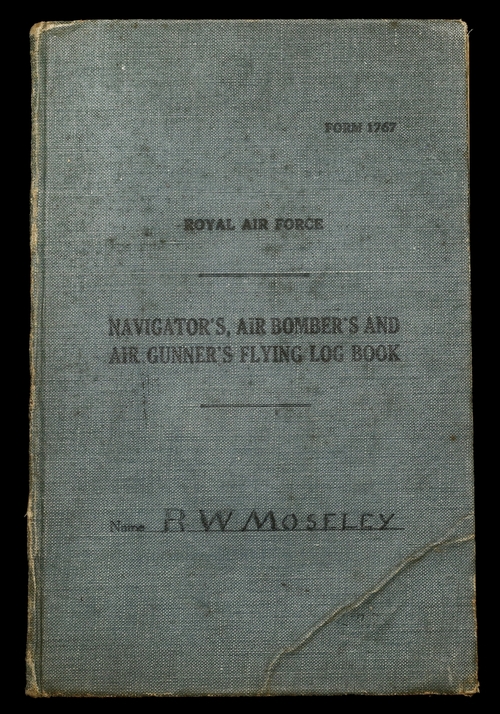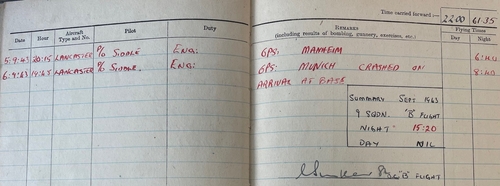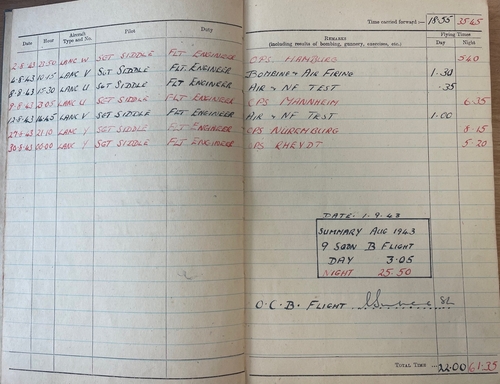Auction: 25002 - Orders, Decorations and Medals
Lot: 212
The Royal Air Force Flying Log Book to Flight Sergeant R. W. Moseley, 9 Squadron Royal Air Force, who survived a crash landing on Lancaster WS/Y which had been hit by flak over Munich on 6 September 1943, leaving one of his eyes hanging from it's socket
The Navigators, Air Bomber's and Air Gunner's Flying Log Book covering the period 16 June 1943 - 6 September 1943 when he served as a Flight Engineer, crease to cover, otherwise good overall condition
Reginald W. Moseley was originally from Bristol and commenced his flying experience on 16 June 1943 and served as a Flight Engineer on an Avro Manchester flown by Sergeant Siddle (later Flight Lieutenant W. E. Siddle D.F.C. & Bar). They both transferred to No. 9 Squadron based at R.A.F. Bardney, Lincolnshire, and began flying on Avro Lancasters on 23 June 1943. His first Op was to Hamburg on 27 July 1943 and this was repeated on 29 July 1943. Moseley again returned to Hamburg on 2 August 1943 and a week later carried out an Op to Mannheim. This was followed up with a visit to Nuremburg on 27 August 1943 and three days later he went to Rheydt (west of Dusseldorf). On 5 September he had an Op to Manheim.
Another Op on 6 September 1943 saw their Lancaster given the task of bombing Munich. The aircraft was airborne at 18:45 and successfully dropped its bombs on the city but was hit by flak shortly afterwards. Despite the smell of petrol they carried on for home, but were unaware of the loss of fuel given that only three of the six fuel gauges were working. The starboard outer engine suffered from overheating and they decided to shut it down for safety. Having crossed the English coast, they prepared to land having given advance warning of their predicament. On their approach to the runway and at about a mile out at a height of 200ft, there was a major change in the sound of the engines followed by popping and coughing with the aircraft swinging sharply to starboard, seemingly out of control. The aircraft briefly dipped downwards before righting itself, the crew were too low to bail out and the hydraulics had failed - meaning the undercarriage and flaps could not be retracted. The Lancaster subsequently lost power hit a tree and crashed at Minting (east of Bardney), the tail section became completely detached along with the rear turret and Air Gunner contained within, the aircraft was damaged beyond repair.
All members of the crew suffered injuries but all survived the crash. Moseley appeared to have come off worst as he suffered a combination of facial cuts as a result of being thrown against the instrument panel and one of his eyes was hanging from his socket, he further suffered with a back injury. As a result of his injuries he was retired from further flying duties.
Having recovered from his injuries and despite being grounded Moseley continued in service and undertook a number of ground crew postings as an engine fitter. He saw service in Burma where he was still serving when the war concluded in the Far East in 1945. Discharged from the Royal Air Force in December 1946, in civilian life he was employed as a fitter for the British Overseas Airways Corporation based at Filton, Bristol, and later for the Bristol Aeroplane Company as an engine designer. He was to work on the lubricating system of the ill-fated Bristol Brabazon and later was involved in the development of the Britannia aeroplane. Moseley moved to Devon in the early 1980s and took over the tenancy of a public house for three years but was to then live in Coventry.
Sold with a copy of Lancaster Valour: The Valour and the Truth by Clayton Moore, 1995.
Subject to 20% VAT on Buyer’s Premium. For more information please view Terms and Conditions for Buyers.
Sold for
£320
Starting price
£110









